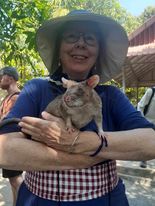On a small scrap of paper headed Guest House, Romchang, I jotted down the following:
Bamboo train
Ancient House
Fruit Bats
Bat Cave
Banan Temple
Battambang Statue
My travel companion had fallen and injured her knee. After seeing she was resting and safe, I thought I might engage a tangible tour guide to show me something of Battambang, a regional town in the Northwest. Like Mr Vanna’s carefully displayed assortment of books, each place gathers and presents that which might be tradeable. The special places, modest or magnificent, with which to ply the tourist trade. Commercial, certainly, yet not without dignity and honour. People must live. The list above comprised the local equivalent of the grand tour.
Bamboo train
Ancient House
Fruit Bats
Bat Cave
Banan Temple
Battambang Statue
My travel companion had fallen and injured her knee. After seeing she was resting and safe, I thought I might engage a tangible tour guide to show me something of Battambang, a regional town in the Northwest. Like Mr Vanna’s carefully displayed assortment of books, each place gathers and presents that which might be tradeable. The special places, modest or magnificent, with which to ply the tourist trade. Commercial, certainly, yet not without dignity and honour. People must live. The list above comprised the local equivalent of the grand tour.
Just for now, I want to write of Ms Bun Roeung’s Ancient House. I’d been struck by the style of Cambodian houses. The local equivalent of McMansions were two or three stories and featured long windows in a range of Monet shades. Chandeliers were in favour. Ostentatious, but not unattractive. Far more appealing, though, were the traditional houses built on simple lines usually on stilts. The older ones tended to be weathered timber, the newer ones in a delicious array of colours that were an antidote to the greige plague of my hometown. Like little jewel boxes. I was curious: was the stilt design protection against flooding or a form of air conditioning?
Khmer Arts and Crafts
In a country whose crown jewel in Angkor Wat, the proud centre of the Khmer Empire which lasted for six centuries, the term ancient raises certain expectations. The tree-surrounded house I was delivered to was of human dimension – a pleasing timber construction that would meet the tenets of the Arts and Crafts ideal. Leaving my shoes at the bottom of a flight of concrete stairs I went up and was greeted by Ms Bun Roeung herself. A set of miniature models on a veranda table displayed the variants of classic Cambodian architecture. She answered my unspoken query by announcing that the design could serve as flood protection, temperature regulation, as well as protection from poisonous animals (I hadn’t thought of that!).
Moving inside to the large main room I was struck with the silkiness of the wide timber floorboards and the uncluttered placement of furniture. Again, it recalled the William Morris maxim “Have nothing in your house that you do not know to be useful or believe to be beautiful”. The beauty was unquestionable. The usefulness both immediately evident and more subtle. My attention was drawn to two mirrors: one large and one small. “Notice,” said Ms Roeung, “how they are placed so that you can observe who approaches the house, while remaining unobserved yourself”. Noted.
Out of time
“The house was built in 1920,” she remarked. I was startled. The Ancient House was eight years younger than my own home in Fremantle. Time dilated. The Theory of Relativity 101. Three generations lived in Ms Roeung’s house, three in my own. I sometimes give a mock house tour for our guests, as three generations is time enough to accrue some interesting tales. And ghosts. It is my infinite, unearned good fortune that my ghosts are benign.
“The house belonged to my aunt, a Professor of Literature” (a calling not very distant from my own). So much relational information. She went on, “More than a hundred members of my family were killed by the Khmer Rouge. My aunt survived and chose to come back.” Time stopped. Viewed across the gulf of rupture, the term “ancient” took on a new meaning. There was the time before and the time after and an immeasurable gap between.
Sampeah
She left me alone, then, in that room. I don’t know what groups of visitors do at this point. Whisper? Look at the furniture or out the window? I looked at the family portraits hanging on one wall and did the only thing that I could think to do: brought my hands together in sampeah, the Cambodian gesture of greeting and respect.
The New Kitchen
When I left the original part of the house, I was shown the kitchen, which was the only section that was new. It had been commandeered by the Khmer Rouge and used to supply local troops. A more compelling reason for remodelling than the hunger for novelty, tear-down-and-replace that plagues my street.
Downstairs, Ms Roeung seemed a little less remote (had I been observed, unobserved?) She asked me where I was from. When I answered “Australia” she replied “Queensland?” I hadn’t mentioned it, but I guess I wasn’t the first person to observe the similarities between the stilt design and the traditional Queenslander. Motes of commonality floating in the vast space-time continuum that separates her history and culture from my own. Occasionally, they catch the light.
Downstairs, Ms Roeung seemed a little less remote (had I been observed, unobserved?) She asked me where I was from. When I answered “Australia” she replied “Queensland?” I hadn’t mentioned it, but I guess I wasn’t the first person to observe the similarities between the stilt design and the traditional Queenslander. Motes of commonality floating in the vast space-time continuum that separates her history and culture from my own. Occasionally, they catch the light.

 RSS Feed
RSS Feed
